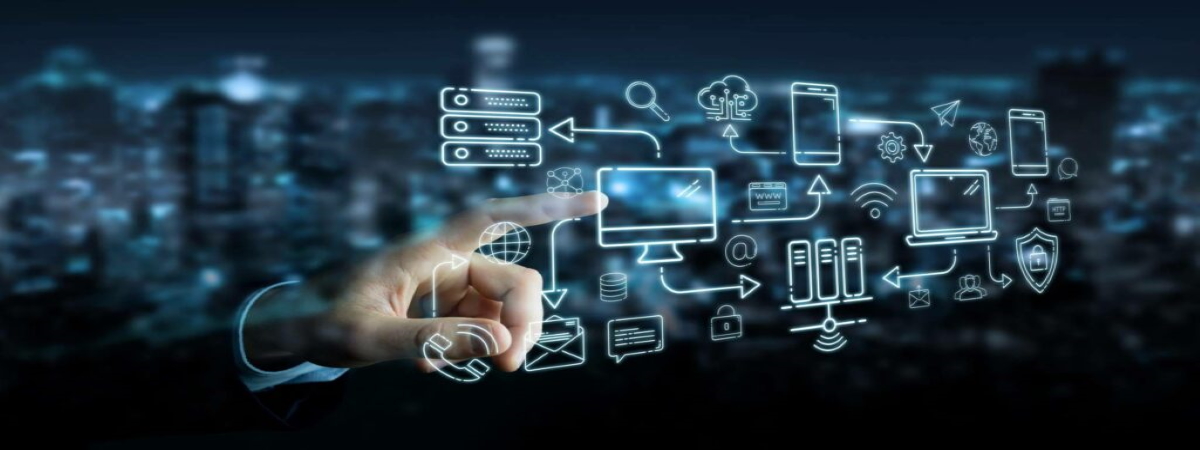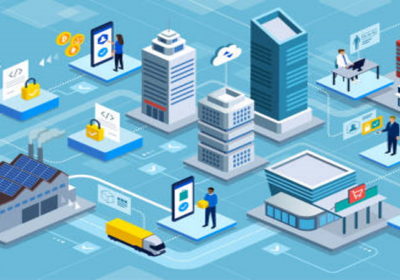
Smart cities are not just a dream of the future. Thanks to the tremendously innovative technology of the Internet of Things (IoT), AI, blockchain and other solutions that fall under the so-called Industry 4.0 paradigm, many are already active and rapidly expanding. So what is IoT and how does it work with smart cities?
The Internet of Things (IoT) is the process of connecting everyday physical objects to the Internet: from common household objects, such as light bulbs, to healthcare resources, such as medical devices; it also encompasses wearables and smart personal accessories, and even the systems that allow us to manage many of the services of smart cities.
How does IoT work?
The term IoT refers to all physical device systems that receive and transfer data over wireless networks with minimal human intervention, made possible by the integration of computing processes into all kinds of objects. For example, a smart thermostat (i.e. one that uses the IoT) can receive location data from your smart car as you drive to adjust the temperature in your home before you arrive. All of this is achieved without your intervention as you already have it pre-programmed beforehand, and even provides a better result than if you were to do it manually while driving or continuously adjusting your home’s settings.
A traditional IoT system, such as home automation systems in the home described above, works by continuously sending, receiving and analyzing data in a feedback loop. Depending on the type of IoT technology, people or artificial intelligence and machine learning (AI/ML) systems can analyze this data almost immediately or over a set period of time in order to gain insight into its status, operation, etc.
Think of the example of smart heating systems that exist for the home. To predict the ideal time to control the thermostat before arriving home, the IoT system can connect to the Google Maps API and thus obtain current information about traffic in the area, if it does not have a direct connection with the navigation systems of your vehicle or with your cell phone to get your location. On the other hand, utilities have the ability to analyze IoT data from customers with smart thermostats to optimize the system on a large scale and be aware of the time of peak demand on the power grid that turning on the heating in thousands of homes at specific times can mean.
How does IoT technology make cities smarter and better?
Applying IoT to Smart City management processes is not complex, even though it is relatively new. Municipal governments in many cities are already leveraging cellular and low power wide area wireless (LPWAN) technologies to connect and improve infrastructure, efficiency, convenience and quality of life for residents and visitors. Secure wireless connectivity and IoT technology are thus turning traditional elements of urban life, such as street lighting, into next-generation smart lighting platforms with expanded capabilities to self-manage their functions and consumption. This includes integrating solar energy for example to power control panels and connecting to a central cloud-based control system that connects to other assets in the urban ecosystem for joint regulation.
These solutions go far beyond simple lighting needs. High-power LED lights integrated into the streetlights themselves alert commuters to traffic problems, provide warnings of adverse weather conditions, and alert when environmental issues, such as fires, arise. Lights along streets and avenues can also detect free parking spaces and electric vehicle charging stations, as well as alert drivers where to find a free space via a mobile app. In some places, electric vehicle charging could even be possible from the public lamp post itself.
Four essential elements to ensure the success of smart cities
But for IoT networks and internet-connected devices throughout the city to work properly, some essential elements are needed for solutions based on these technologies and implemented in smart cities to be successful. Therefore, things such as are required:
- Pervasive wireless connectivity.
- Open data
- Reliable security
- Flexible monetization schemes that allow the cost of implementing the technology to be borne.
As is obvious, the first component of any smart city IoT application is reliable and ubiquitous wireless connectivity. While there is no one-size-fits-all solution, evolving low power wide area network (LPWAN) technologies are ideal for most applications due to their cost-effectiveness and ubiquity. This includes LTE Cat M, NB-IoT, LoRa, Bluetooth and a few others that contribute to interweaving connected cities, also keeping in mind that the arrival of 5G technology is expected to be a milestone that will popularize the technological transformation in Smart Cities and accelerate new deployments of network-connected systems.
Opening the data vault
Historically, governments, businesses and individuals have kept their data close at hand and shared it as little as possible with others. Privacy concerns and fear of security leaks have far outweighed the perceived value of sharing information. However, a key factor in achieving sustainable smart cities is for all participants in the complex ecosystem to share non-sensitive information and combine it with contextual data that is analyzed in real time. Multiple sectors and data capturers must cooperate to achieve better results by analyzing information through big data processes, which is shared between sector-specific information systems and operational technology systems.
Amsterdam is a shining example of a well-connected smart city that is reaping the rewards of opening its data vault. It shares transit and transportation data with stakeholders, such as developers, who then create mapping applications that connect to the city’s transportation systems. This makes navigating the city easier for everyone. In addition, the city built autonomous delivery boats called “roboats” to move things more quickly and efficiently along the city’s network of canals. It also supported a floating village of houses, solving the city’s overcrowding problem with a sustainable, energy-efficient alternative. Power is generated within the communities, and the houses receive water directly from the river and filter it in their own reservoirs. None of this is possible without shared data.
Copenhagen is another example of a Smart City that is also leveraging open data in its collaboration with the Massachusetts Institute of Technology (MIT) to develop an innovative smart bike system integrated with sensors that provide real-time information to both users and administrators. Data is shared to monitor and manage air quality and traffic congestion.
Can smart cities be safe and reliable?
Connected cameras, smart road systems and public safety surveillance systems can provide an additional layer of protection and emergency support to help citizens when they need it. But what about protecting smart cities themselves from vulnerabilities – how can we defend against hackers, cyberattacks and data theft? In cities where multiple participants share information, how can we trust that the participants are who they say they are? And how do we know that the data they communicate is true and accurate? The answer lies in authentication and identity management solutions.
Smart city services and infrastructure can only work if we can trust them. All ecosystem partners – governments, enterprises, software vendors, device manufacturers, energy providers, network service providers, etc., – must do their part and integrate solutions that meet four basic security objectives:
- Availability: without actionable, real-time, reliable access to data, the city cannot thrive. How data is collected, distilled and shared is critical, and security solutions must avoid negative effects on availability.
- Integrity: Smart cities depend on reliable and accurate data. Measures must be taken to ensure that data is accurate and not manipulated.
- Confidentiality: Some of the data collected, stored and analyzed will include sensitive consumer information. Measures should be taken to prevent unauthorized disclosure of confidential information..
- Accountability:: Users of a system should be held accountable for their actions. Their interactions with sensitive systems should be logged and associated with a specific user. These records must be difficult to falsify and have strong integrity protection.
To achieve these basic security objectives, strong authentication and identity management solutions must be integrated into the ecosystem to ensure that data is shared only with authorized parties. Solutions also protect backend systems from intrusions and hacking, and fortunately, as a result of the growing concern for digital security, legislation is being introduced to address threats and potential market failures in many countries..
How are smart cities monetized?
In the age of IoT and smart cities, data is the new oil. For smart cities to thrive, we must establish sustainable business models that facilitate the success of all players in the ecosystem. Software must be integrated into the fabric of IoT solutions so that all contributors to the ecosystem benefit, this includes enterprises, developers, integrators, governments, etc.
The intellectual property of the information that each member brings to the table with the technology solutions that are deployed in the city should be valued and rewarded. SaaS capabilities enable new business models that empower each partner to extract value from their contribution to the ecosystem, monetizing the solutions they deliver to the city for the management of its services. It is a way to monetize the hardware and software used to build smart infrastructures and spread the costs to avoid a huge one-time capital expenditure. Expensive medical equipment, such as MRI scanners, for example, can be sold on a cost-per-scan basis, rather than as a one-time upfront expense for hospitals. This is a win-win for both hospitals and providers. And, soon, cities will offer affordable subscriptions to fleets of vehicles shared among owners who can choose from a variety of customized options. This could radically reduce traffic and optimize transit patterns and ridesharing.
As urban areas continue to expand and grow, smart city technology is expanding to improve sustainability and better serve humanity, and IoT is key to this. By leveraging ubiquitous connectivity, open data, comprehensive security, and monetization solutions offered by multi-service management software, we can align the evolving needs of smart cities to achieve a highly enhanced experience for all ecosystem partners.



